South Kona, Ka’u and Puna: Wild Southern Coastline, Immense Volcanic Mountains and Mysterious South Point
Approximate minimum time start to finish (to see every site): 12 hours.
Headed south from Kona, connect to Highway 11 and drive 20 minutes to sample Kona Coffee. Numerous farms offer tours to discover the history and processing of this highly prized beverage. In this region are Kealakekua Bay and the Captain Cook Monument, the locations where Hawai'ian history was forever changed and the best snorkeling in the state. Follow the beach road 10 minutes to Pu'u Honua 'O Honaunau National Historic Park. Discover why this spiritual complex was a "place of refuge". Continuing south 1 hour, after some beach time and a short hike, is South Point Road. This is where early Polynesians arrived and started a village based on the rich fishing grounds offshore. Nearby is the trail for a 3 hour round trip hike to a Green Sand Beach (bring drinking water). Then drive 30 minutes south to visit endangered Hawksbill Sea Turtles at Punalu'u Black Sand Beach. From Punalu'u it is a 2 hour drive back to Kona.
Leg 1) Start at north end of Keauhou Historic District on Ali’i Drive, head south on Ali’i Drive to jct with Kamehameha II Hwy; east on Kamehameha III to Hwy 11. Take Hwy 11 south to jct with Hwy 160, just south of the town of Captain Cook. Head downhill on Hwy 160 to Napo’opo’o Village, turn north on Pu’uhonua Beach Road to Kealakekua Bay State Historical Park at end of road; this is where you view the Captain Cook Monument.
Keauhou Historic District and Kona Coffee
For almost 400 years, temples and palaces along the Kona coastline served as a kind of "Rome of the Pacific", a great political, religious and cultural center in Polynesia, until the capital was moved to Honolulu in 1850 by Kamehameha III. The most important, interesting and best preserved historical and cultural sites lie within the Keauhou Historic District, between Kahalu'u Beach Park in Kailua running south 6 miles to Kuamo'o Bay in Keauhou. The District contains perhaps a dozen fascinating sites that are easy to walk to, well maintained and quite interesting.
To see the numerous fascinating and important archaeological sites in the Keauhou Historic District, it is necessary to park your car in the free parking at either Kahalu’u Beach Park or the Keauhou Beach Resort and explore on foot.
Just uphill from the Historic District is the Kona Coffee District. Hawaii is the only state in the union which produces coffee, and Kona coffee is perhaps the finest in the world. Over 2 millions pounds of coffee a year are produced on about 600, 2-3 acre farms; tours of coffee farms and roasteries are available.
Kealakekua Bay Historical District and Captain Cook Monument
A place of both dramatic historic events and unparalleled scenery, beautiful and now peaceful Kealakekua Bay (Pathway of the Gods) opens beneath steep, beetling cliffs on the ancient surfing beach along the shoreline of Napo’opo’o Village. The site of arguably the most important event in the history of Polynesia, home to pods of frolicking dolphins, providing some truly breathtaking snorkeling, Kealakekua Bay is one of the most magical spots in the State of Hawai’i.
Across the bay from Napo’opo’o stands the solitary white obelisk that marks the lonely Captain Cook Monument. It was in this broad bay that Captain James Cook made his deepest impression on, and longest visit with, native Hawai’ians when he first arrived late in November of 1778; and it was here where he met his tragic end in February 1779 during his second visit. At the State Park at the end of the road in Napo'opo'o are picnic facilities, pavilions and restrooms.
Place of Refuge: Pu’u Honua O Honaunau National Historic Park
A beautiful, peaceful, restful piece of Old Hawai’i, Pu’u Honua O Honaunau is a place of ease and regeneration for weary and jaded souls. Of enormous historical and cultural significance, the sacred grounds at Honaunau are the best-preserved remaining Pu’u Honua, or Place of Refuge, complex in Hawai’i. It is also a wonderful area to wander, snorkel, relax and picnic. For anyone who had any doubts about what Old Hawai’i was like, a trip to Honaunau will fill your imagination, your camera and your spirit.
A complex and strict order of law, known as the kapu system, controlled and governed everything in ancient Hawai’i. Under this system, judgment was death, immediate and final, unless the accused could escape to one of the designated places of refuge. There the accused would undergo a cleansing ceremony, be absolved of all crimes, and allowed to return to his family free of onus. The National Park has a Visitor's Center and bookshop, full picnic and restroom facilities. Although no swimming or snorkeling is allowed within the Park, adjacent is Two-Step Beach on Hounaunau Bay, one of the premiere snorkeling spots on the Island.
Leg 3) Return to Hwy 11 via south leg of Hwy 160, continue south on Hwy 11 to Ho’okena Beach Road; Ho’okena Beach Road west to Ho’okena Beach.
Ho’okena Beach County Park
Brilliant snorkeling, decent boogie boarding, passable shell collecting and wonderful camping—it’s a wonder Ho’okena Beach is not more popular with visitors. Nestled alongside the ruins of Ho’okena Village, this beach is a wonderful place to spend a morning or a weekend.
Frequented by dolphin, stuffed full of pelagic and reef fish and turtles and boasting crystal clear, warm and calm waters, Ho’okena is a must-see beach for avid snorkelers and divers as well as sea kayakers. During the winter months, female Humpback whales and their babies frequent the waters off this bay.
Wonderful beach camping, new showers and restrooms, picnic tables and abundant fresh water make this county park a gem. Camping is by permit only on a first come-first served basis.
Leg 4) Return to Hwy 11 via Ho’okena Beach Road; continue south on Hwy 11 to Miloli’i Road; Miloli’i Road to Miloli’i Beach Park; trail to Honomalino Beach.
Honomalino Bay
A true gem of West Hawai’i and rarely crowded, Honomalino Bay is reached by a 20 minute hike from the south end of Miloli’i Beach County Park. The hike starts between the bathrooms and a yellow church and is always along the right fork of the trail, in and out of the surf line, to avoid private property.
Snorkeling is very interesting on the north side in the rocks, when the surf is low. The water, though very clear, is sometimes quite cold due to spring discharge in the sand on the beach. There are no services here, leave no valuables in your car.
Leg 5) Return to Hwy 11 via Miloli’i Road and continue south on Hwy 11 to South Point Road; South Point Road to South Point.
South Point (Ka Lae)
Haunting, windswept, wild, empty, beautiful. Imagine the gratitude and wonder of the first Polynesians who, after voyaging at sea without sight of land for more than a month, finally made land here at Ka Lae. Polynesians established a thriving colony based upon the incredibly rich fishing grounds just offshore. South Point is the farthest point south in the entire United States. The road to Ka Lae from the Hawai’i Belt Road is infamous although greatly improved in recent years; check your rental agreement before driving here. There are no services…plan and act accordingly.
Leg 6) Head back north on South Point Road to Kaulana Boat Launch Road; take road to boat launch, Green Sand Beach trail to Green Sand Beach.
Trail to Green Sand Beach
Absolutely unique to the island of Hawai’i are the handful of green sand beaches composed of crystals of the semi-precious mineral olivine (also known as peridot). The green sand beach at South Point is the best known, largest and most accessible of these. The bizarre color of the water shrieks for underwater photographs. Watch for strong currents; do not go out far nor if the surf is high or there are strong winds.
To get there, follow signs to Kaulana boat launch; park left (south) of the boat launch. Hiking distance is 2 ¼ miles each way along rolling tropical prairie. Stay in sight of the shore and you cannot get lost. Although tricky to spot on the way down, from the beach looking up the way back to the crater rim is easy to follow. There are no services here; plan and act accordingly.
Leg 7) Return from Kaulana Boat Launch Road to South Point Road to Hwy 11; proceed southeast on Hwy 11 to Punalu’u Road; Punalu’u Road to Punalu’u Black Sand Beach Park.
Punalu’u Black Sand Beach Park
A truly remarkable place of great peace, beauty and spiritual healing, Punalu’u’s black sand beach is world-renowned. Endangered Hawai’ian Green Sea Turtles swim the waters here and bask on the beach. The wildness of the ocean and the serenity of the freshwater fishpond and coconut palm-shaded beaches make this an ideal place to spend some soul-recharge time. The ocean here can be rough, so use caution when swimming.
Available services include water, picnic tables, restrooms, electrical outlets, and pavilions, parking; camping is by permit only. During peak tourist time, there is a souvenir stand with some packaged food items and canned drinks for sale, otherwise the nearest food, gasoline and other services are in either Pahala or Na'alehu.
Leg 8) Return Punalu’u Road to Hwy 11; take Hwy 11 west and north to Kailua Kona.
For more information on traveling to Hawaii in general and touring on the Big Island in particular, please visit www.tourguidehawaii.com and www.lovingthebigisland.wordpress.com. For information about the author, please go here.
All media copyright 2009 by Donald B. MacGowan; all rights reserved.
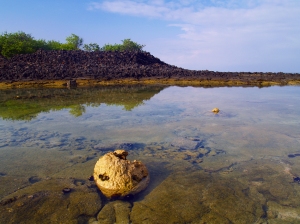
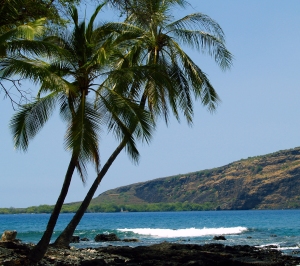

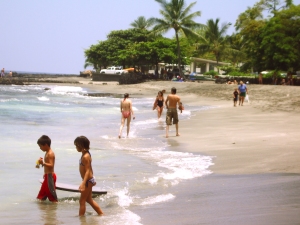
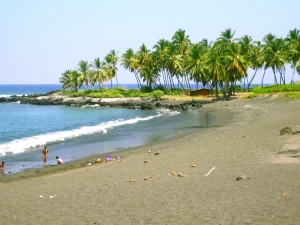
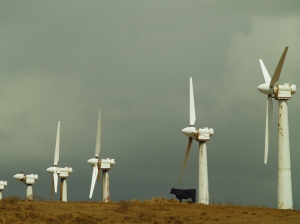
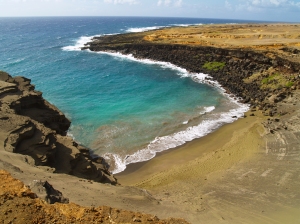
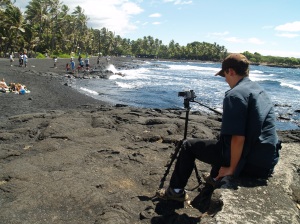
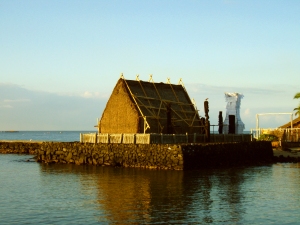

No comments:
Post a Comment